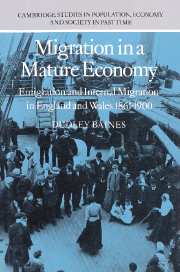Book contents
- Frontmatter
- Contents
- List of tables
- List of figures
- Acknowledgements
- 1 Introduction: the scope of the study
- 2 Issues in the history of European emigration, 1840–1914
- 3 The characteristics of British emigrants before 1914
- 4 The estimation of migration by county of birth
- 5 Return migration to Britain, 1860–1914
- 6 The birthplace of English and Welsh emigrants, 1861–1900
- 7 English and Welsh emigrants in the 1880s and 1890s
- 8 Emigration and urban growth
- 9 Rural-urban stage emigration, 1861–1900
- 10 Wales and the Atlantic economy, 1861–1914
- A summary of conclusions
- Appendices
- Bibliography
- Index
8 - Emigration and urban growth
Published online by Cambridge University Press: 24 November 2009
- Frontmatter
- Contents
- List of tables
- List of figures
- Acknowledgements
- 1 Introduction: the scope of the study
- 2 Issues in the history of European emigration, 1840–1914
- 3 The characteristics of British emigrants before 1914
- 4 The estimation of migration by county of birth
- 5 Return migration to Britain, 1860–1914
- 6 The birthplace of English and Welsh emigrants, 1861–1900
- 7 English and Welsh emigrants in the 1880s and 1890s
- 8 Emigration and urban growth
- 9 Rural-urban stage emigration, 1861–1900
- 10 Wales and the Atlantic economy, 1861–1914
- A summary of conclusions
- Appendices
- Bibliography
- Index
Summary
The relation between urban growth and emigration has been an important issue in the literature on European emigration. Migration to the cities and emigration have often been thought of as substitutes because a potential emigrant had the option of moving to a city within his own country. The implication of this view is that (if other things remained equal) emigration would fall as a country became more urbanised. It has been argued, for example, that the fall in the rate of emigration from Germany after the 1880s was because the eastern German emigrants were increasingly diverted to the industrial areas of western Germany. It has also been argued that the high rate of emigration from Ireland and Italy in the same period was because there was little urban development.
It is obvious that emigration must have been affected by urban growth and by modern industrial development. But it is not obvious that in most European countries there was a simple trade-off between rural–urban migration and emigration. The idea of a trade-off assumes that the emigrants came from the rural areas and is not dissimilar from a commonly expressed view that the emigrants came from those areas where there was no industrialisation. But there are many countries where urban growth does not seem to have inhibited emigration. Emigration rates from the urban areas of European countries were often high and sometimes higher than from the rural areas. This was true of England and Wales in the late nineteenth century where there was hardly any difference between the propensity to emigrate of natives of urban and rural counties.
- Type
- Chapter
- Information
- Migration in a Mature EconomyEmigration and Internal Migration in England and Wales 1861–1900, pp. 213 - 249Publisher: Cambridge University PressPrint publication year: 1986



